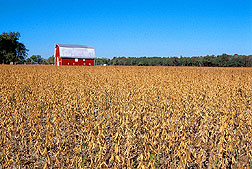This page has been archived and is being provided for reference purposes only. The page is no longer being updated, and therefore, links on the page may be invalid.
|
|
|
|
Extreme Weather Boosts Antioxidant Levels in Soybean Seeds
By Rosalie Marion Bliss
December 17, 2008
Agricultural Research Service (ARS) scientists have found that weather and climate play key roles in levels of a family of antioxidants tucked inside soybean seeds.
Lead plant physiologist Steven Britz of the ARS Food Components and Health Laboratory, part of the Beltsville Human Nutrition Research Center in Beltsville, Md., collaborated on the study with William Kenworthy with the University of Maryland in College Park.
The researchers found that weather and climate are significant factors affecting soybean seed tocopherol content. Tocopherols are a family of antioxidants that protect biological membranes. Among this family, alpha-tocopherol is the active form of vitamin E in humans.
Soybean seeds are a major source of vegetable oil in the U.S. diet, and consequently a major contributor to dietary tocopherol intake. The daily Recommended Dietary Allowance for vitamin E for men and women aged 14 and older is 15 milligrams. But more than 50 percent of American adults do not get adequate amounts of vitamin E, according to experts.
For the study, the researchers analyzed the content of tocopherols in soybean seeds grown at several locations in Maryland between 1999 and 2002. Weather was relatively normal between 1999 and 2001, but extreme drought and warmer temperatures characterized 2002.
Since soybeans mature at different rates, the researchers examined up to 18 soybean lines representing different maturity groups. There were small but significant increases in the proportion of alpha-tocopherol in beans from the same genetic line grown in warmer, full-season Eastern Shore locations compared to beans that matured under slightly cooler conditions.
But under extreme drought conditions in 2002, early maturing lines had as much as a 3.5-fold increase in relative alpha-tocopherol content, compared to the other years during which rainfall was adequate.
The field studies showed how nutritional properties of crops can be dramatically affected by weather and potentially by global environmental change, according to the authors.
The research was reported recently in the Journal of the American Oil Chemists' Society.
ARS is a scientific research agency in the U.S. Department of Agriculture.

